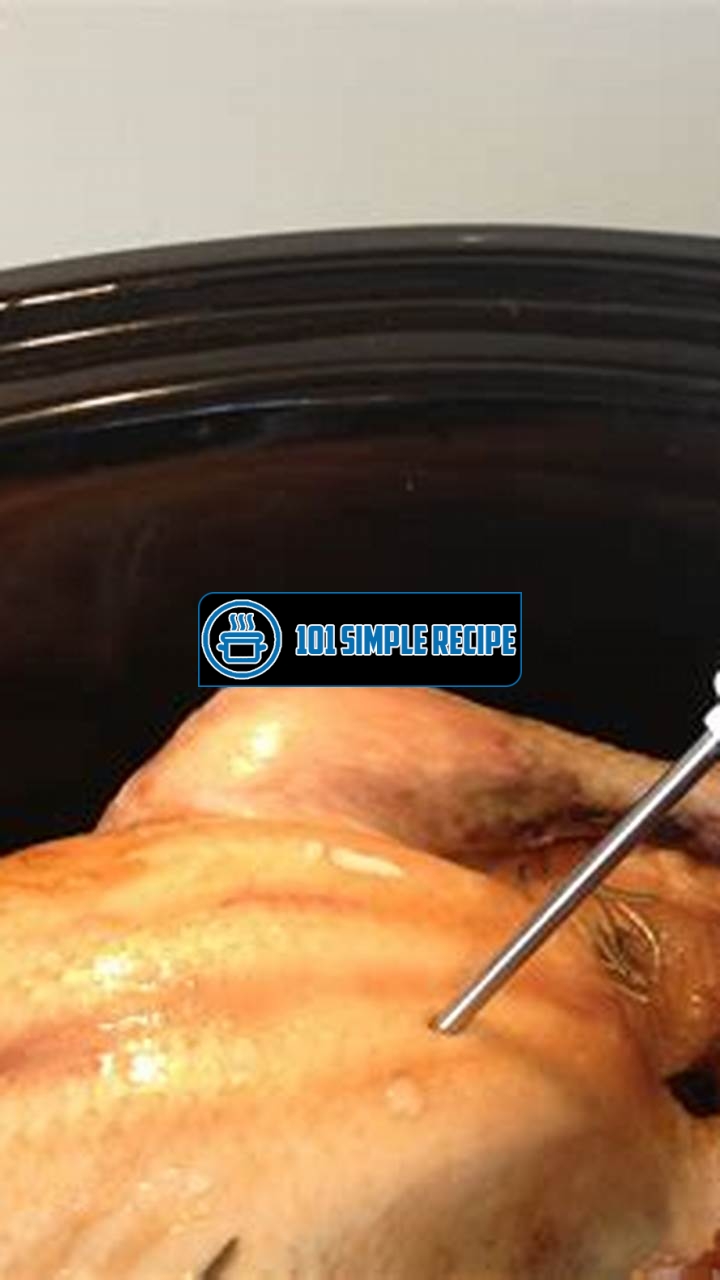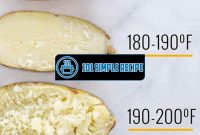Are you tired of dry and flavorless chicken breast? Look no further, because we have the secret to achieving moist and tender chicken breast every single time! ✨ Whether you’re preparing a simple weeknight dinner or hosting a special gathering, having perfectly cooked chicken breast can make all the difference. In this article, we will reveal the tried-and-true techniques and tips that will ensure your chicken breast is juicy, tender, and bursting with flavor. Say goodbye to boring chicken and hello to culinary excellence! So, let’s dive right in and discover the secret to achieving the most delightful chicken breast you’ve ever tasted. ️

Understanding Chicken Breast Temperature
Discover the importance of getting the chicken breast temperature just right for a perfectly cooked and safe-to-eat meal.
Why Temperature Matters
Understanding the correct temperature for cooking chicken breasts is crucial in achieving a moist and tender result. When cooked at the right temperature, the chicken breast retains its juiciness, flavor, and nutritional value. On the other hand, cooking the chicken breast at too high or too low a temperature can result in dry and tough meat.
Temperature impacts the texture and taste of the chicken breast, making it an essential factor to consider when preparing your meal.
Safe Temperature Guidelines
It is vital to cook chicken breasts to an internal temperature that ensures it is safe to eat. The United States Department of Agriculture (USDA) recommends cooking chicken breasts to an internal temperature of at least 165°F (74°C).
For maximum safety, chicken breasts should be cooked until they reach an internal temperature of 165°F (74°C).
Using a meat thermometer is the most accurate way to determine the internal temperature of cooked chicken breasts. Insert the thermometer into the thickest part of the breast, making sure it does not touch the bone. Once the chicken breast reaches the recommended temperature, remove it from the heat source and let it rest for a few minutes before slicing or serving.
Properly cooked chicken breasts not only ensure food safety but also provide a juicy and flavorful dining experience.
Factors that Affect Cooking Time
Several factors can impact the cooking time required to reach the desired temperature for chicken breasts.
1. Thickness: Thicker chicken breasts will take longer to cook compared to thinner ones. It is important to consider the thickness of the breast when determining the cooking time.
2. Starting Temperature: The temperature of the chicken breast before cooking can affect the overall cooking time. If the chicken breast is cold, it will take longer to cook than if it is at room temperature.
3. Cooking Method: The cooking method utilized can also influence the cooking time. Grilling, baking, or pan-searing may require different cooking times.
4. Oven Accuracy: Variations in oven temperature can affect cooking time. It is recommended to use an oven thermometer to ensure accurate temperature control.
By considering these factors, you can adjust the cooking time accordingly and achieve a perfectly cooked chicken breast.
Note: Remember to always handle raw chicken breasts safely, keeping them refrigerated until ready for cooking. Additionally, wash your hands, utensils, and cutting board thoroughly after handling raw chicken to prevent cross-contamination.
The Role of Internal Temperature in Chicken Breast
When it comes to cooking chicken breast, the internal temperature plays a crucial role in ensuring not only the safety but also the optimal taste of the meat. It is important to understand the science behind achieving the perfect internal temperature for moist and tender chicken breast.
Principles of Cooking Chicken
Before we delve into the specifics of internal temperature, let’s first understand the basic principles of cooking chicken. The key to preparing a delicious chicken breast lies in achieving the perfect balance between keeping the meat safe from harmful bacteria and preserving its natural juices for a succulent texture.
Chicken is considered safe to eat when it reaches an internal temperature of 165°F (74°C), as recommended by the USDA. However, cooking chicken to this temperature alone might not result in the most desirable texture. In fact, overcooking chicken can lead to dry and tasteless meat.
To overcome this problem and ensure a moist and tender chicken breast, it is essential to cook the chicken to an internal temperature slightly lower than the recommended safe temperature. This allows the residual heat to continue cooking the meat while it rests, resulting in a perfect level of doneness.
Note: It is important to use a meat thermometer to accurately measure the internal temperature of the chicken breast and avoid any guesswork. This will help you achieve consistent and reliable results.
Importance of Meat Thermometers
Meat thermometers are indispensable tools for any aspiring chef or home cook. They provide an accurate reading of the internal temperature of the chicken breast, ensuring that it reaches the desired level of doneness without sacrificing safety.
There are two main types of meat thermometers: instant-read thermometers and oven-safe thermometers. Instant-read thermometers are inserted into the chicken breast and give a quick temperature reading within seconds. They are versatile and suitable for various cooking methods, including grilling, pan-searing, or roasting in the oven.
Oven-safe thermometers, on the other hand, are inserted into the chicken breast before it goes into the oven and remain in place throughout the cooking process. This allows you to monitor the temperature without opening the oven door, ensuring a consistent cooking environment.
Note: Remember to insert the meat thermometer into the thickest part of the chicken breast, avoiding contact with bones or the cooking surface, as this may give inaccurate readings.
Testing Chicken Doneness
Testing the doneness of chicken breast is crucial to achieving the desired level of internal temperature. Apart from using a meat thermometer, there are a few visual and tactile cues to look out for.
One reliable method to determine if the chicken is done is to make a small incision with a knife near the thickest part of the breast. If the juices run clear and there is no trace of pink, the chicken is likely cooked through.
Another way to test doneness is by gently pressing the chicken breast. If it feels firm yet still slightly springy, the meat is cooked to perfection. On the other hand, if it feels soft and squishy, it needs more cooking time.
Note: Always let cooked chicken breast rest for a few minutes before cutting into it or serving. This allows the juices to redistribute, resulting in a juicier and tastier final dish.
In conclusion, understanding and controlling the internal temperature of chicken breast is vital for both safety and flavor. By following the principles of cooking chicken, using meat thermometers accurately, and testing for doneness, you can achieve moist and tender chicken breast that will leave your taste buds satisfied. So, go ahead and cook your chicken with confidence, knowing that you have mastered the secret behind delicious poultry dishes.
Preparation and Seasoning Tips
When it comes to cooking chicken breast, the preparation and seasoning techniques you use can greatly influence the final result. By taking the extra time and effort to properly prepare and season your chicken breast, you can ensure that it turns out moist, tender, and packed with flavor. Below, we will explore various methods to elevate the taste and tenderness of your chicken breast:
Brining Techniques
Brining is a popular method used to enhance the moisture and tenderness of chicken breast. It involves soaking the chicken in a solution of salt and water before cooking. The salt in the brine helps to break down the proteins in the meat, allowing it to retain more moisture during the cooking process. To make a basic brine, dissolve salt in water until it reaches a sufficient salinity level and then submerge the chicken breast in the brine for at least an hour. The longer it brines, the more flavorful and tender the chicken breast will be.
Aside from a basic salt water brine, you can also experiment with adding other ingredients to the brine solution to infuse additional flavors into the chicken. For instance, you can include herbs, spices, garlic, or even citrus fruits like lemon or lime. These additions can add depth to the taste profile of your chicken breast and elevate it to a whole new level.
Marinades and Rubs
Marinades and rubs are another great way to enhance the flavor and tenderness of chicken breast. Marinades are liquid-based mixtures that typically contain acidic ingredients like vinegar, citrus juice, or yogurt, along with various seasonings and spices. By marinating the chicken breast for several hours or overnight, the meat absorbs the flavors from the marinade and becomes more tender. Additionally, the acidity in the marinade helps to break down the muscle fibers in the chicken, resulting in a juicy and flavorful outcome.
Rubs, on the other hand, are dry mixtures that are applied directly onto the surface of the chicken breast. Rubs typically consist of herbs, spices, salt, pepper, and sometimes sugar. By allowing the rub to sit on the chicken breast for at least 30 minutes before cooking, the flavors penetrate into the meat, providing a burst of taste in every bite. Rubs are particularly great for grilling or roasting chicken, as they create a delicious crust that locks in the moisture.
Seasoning for Different Cuisines
Chicken breast is an incredibly versatile protein that can be prepared in various cuisines. By exploring different seasoning options, you can transform a simple chicken breast into a flavorful dish inspired by different cultures. Here are some ideas for seasoning chicken breast based on different cuisines:
- Italian: Infuse your chicken breast with flavors of Italy by using a combination of dried herbs like basil, oregano, and thyme, along with garlic and olive oil.
- Mexican: Spice up your chicken breast with Mexican-inspired flavors by using a blend of cumin, chili powder, paprika, oregano, and garlic. You can also add a hint of lime for a tangy twist.
- Asian: Give your chicken breast an Asian twist by using ingredients like soy sauce, ginger, garlic, sesame oil, and a touch of honey or brown sugar.
- Mediterranean: Bring the flavors of the Mediterranean to your chicken breast by combining lemon juice, garlic, oregano, thyme, parsley, and olive oil.
- Indian: Immerse your chicken breast in a mixture of spices commonly used in Indian cuisine, such as turmeric, cumin, coriander, paprika, ginger, garlic, and yogurt.
By experimenting with different seasonings from around the world, you can create a wide variety of delicious and unique chicken breast dishes that will impress your taste buds and those of your family and friends. ️
Remember, the secret to achieving moist and tender chicken breast lies in the preparation and seasoning. Whether you choose to brine, marinate, or season with different flavors, these techniques will undoubtedly elevate your chicken breast to a whole new level of culinary excellence. So go ahead, get creative, and enjoy the juicy and flavorful results of your efforts!
Cooking Methods and Temperature Recommendations
When it comes to cooking chicken breast, the key to achieving a moist and tender result lies in understanding the different cooking methods and the recommended internal temperatures for each. Whether you prefer grilling, baking and roasting, or sautéing and pan-frying, knowing the ideal temperature range will help you cook chicken breast to perfection every time.
Grilling Chicken Breast
Grilling is a popular method to cook chicken breast, as it imparts a smoky and charred flavor while keeping the meat tender. To ensure your chicken breast is fully cooked and safe to eat, the internal temperature should reach 165°F (74°C). This temperature is crucial to kill any harmful bacteria and make the chicken safe for consumption.
- Preheat your grill to medium-high heat.
- Season the chicken breast with your preferred spices and marinade.
- Place the chicken on the grill grates and cook for about 6 to 8 minutes per side, or until the internal temperature reaches 165°F (74°C).
- Remove the chicken from the grill and let it rest for a few minutes before serving.
Baking and Roasting Chicken Breast
Baking and roasting in the oven is another reliable method to cook chicken breast evenly. The recommended internal temperature for baked or roasted chicken breast is also 165°F (74°C). This temperature ensures that the chicken is fully cooked while retaining its moisture and tenderness.
- Preheat your oven to 425°F (220°C).
- Place the chicken breast on a baking sheet or in a baking dish.
- Bake for approximately 20 to 25 minutes or until the internal temperature reaches 165°F (74°C).
- Allow the chicken to rest for a few minutes before slicing or serving.
Sautéing and Pan-Frying Chicken Breast
If you prefer a quick and convenient cooking method, sautéing and pan-frying are excellent choices for chicken breast. It results in a golden-brown exterior and a juicy interior. For safe consumption, the internal temperature should still reach 165°F (74°C).
- Heat a frying pan or skillet over medium-high heat.
- Add a small amount of oil or butter to the pan.
- Place the chicken breast in the pan and cook for about 6 to 8 minutes per side, or until the internal temperature reaches 165°F (74°C).
- Remove the chicken from the pan and let it rest for a few minutes before slicing or serving.
By following the recommended internal temperatures for each cooking method, you can ensure that your chicken breast turns out moist, tender, and safe to eat. Remember to use a meat thermometer to check the internal temperature and adjust the cooking time accordingly. Enjoy your perfectly cooked chicken breast!
Frequently Asked Questions about Chicken Breast Temperature
Get answers to common queries regarding chicken breast temperature to ensure a smooth cooking experience.
How long does it take to cook chicken breast?
Cooking chicken breast to the perfect temperature is essential to ensure it is moist and tender. The cooking time will depend on the method you choose, as well as the thickness of the chicken breast. As a general guideline, a 4-ounce chicken breast should take about 20-25 minutes to cook in a preheated oven at 425°F (218°C). However, it is always safest to rely on a meat thermometer to determine doneness. The internal temperature of the chicken breast should reach 165°F (74°C).
Note: Cooking times can vary depending on the size of the chicken breast and the specific cooking method. It is crucial to use a meat thermometer to ensure the chicken is cooked to a safe internal temperature.
Can I eat slightly pink chicken breast?
No, it is not safe to eat chicken breast that is still pink in the center. Chicken must be cooked thoroughly to kill any harmful bacteria that may be present, such as salmonella. Consuming undercooked chicken can lead to food poisoning and various illnesses. Always ensure that the chicken breast is cooked until it reaches an internal temperature of 165°F (74°C) for safe consumption.
Note: It is recommended to use a meat thermometer to ensure that the chicken breast has reached a safe internal temperature. Do not rely solely on the appearance of the meat to determine doneness.
What if my chicken breast is overcooked?
Overcooking chicken breast can result in a dry and tough texture, making it less enjoyable to eat. However, if you accidentally overcook your chicken breast, there are a few techniques you can try to salvage the dish:
- Brining: Soak the overcooked chicken breast in a brine solution for a few hours. This can help add moisture back into the meat and improve its texture.
- Marinating: Use a marinade to add flavor and moisture to the overcooked chicken breast. Allow the chicken breast to marinate for at least an hour, then cook it using a shorter cooking time to prevent further drying.
- Shredding: If the overcooked chicken breast is too dry to be enjoyed as-is, consider shredding it and using it in dishes such as salads, soups, or sandwiches. Combining it with dressings or sauces can help mask the dryness.
Note: Prevention is always better than fixing an overcooked chicken breast. Pay close attention to the cooking time and temperature to avoid overcooking in the first place.
By understanding the optimal cooking time and temperature for chicken breast, as well as the importance of proper doneness, you can ensure that your chicken is always moist and tender. Remember to use a meat thermometer to accurately gauge the internal temperature and practice safe cooking techniques for a delicious and safe chicken dish.
Frequently Asked Questions
Thank you for reading our article on chicken breast temp. We hope you found it informative and helpful in your cooking endeavors. If you have any further questions or need more information, please refer to the FAQs below:
| No. | Questions | Answers |
|---|---|---|
| 1. | What is the ideal temperature for cooking chicken breast? | The ideal internal temperature for cooked chicken breast is 165°F (74°C). This ensures that the chicken is safe to eat and fully cooked. |
| 2. | How can I check the temperature of chicken breast without a thermometer? | If you don’t have a thermometer, you can check the doneness of chicken breast by making a small incision. The meat should be white and opaque, and the juices should run clear. |
| 3. | Can I cook chicken breast at a lower temperature for a longer time? | While it is possible to cook chicken breast at a lower temperature for a longer time, it is not recommended as it may result in dry and overcooked meat. It is best to cook chicken breast at the recommended temperature for optimal results. |
| 4. | Should I let chicken breast rest before slicing? | Yes, it is recommended to let chicken breast rest for a few minutes before slicing. This allows the juices to redistribute, resulting in a juicier and more flavorful meat. |
| 5. | Can I marinate chicken breast before cooking? | Yes, marinating chicken breast before cooking can add flavor and tenderness to the meat. It is recommended to marinate chicken breast for at least 30 minutes to a few hours before cooking. |
| 6. | What are some popular seasonings for chicken breast? | Some popular seasonings for chicken breast include garlic powder, paprika, Italian seasoning, and lemon pepper. You can also experiment with your favorite herbs and spices to suit your taste. |
Closing Thoughts
Thank you for taking the time to read our article on chicken breast temp. We hope you found the information valuable and that it helps you achieve perfectly cooked chicken breasts every time. For more cooking tips and recipes, be sure to visit our website again in the future. Happy cooking!
Jump to Recipe
Perfectly Cooked Chicken Breast

Learn the ideal temperature for cooking chicken breast to ensure it is juicy and delicious.
- 4 boneless (skinless chicken breasts)
- 1 tablespoon olive oil
- 1 teaspoon salt
- 1/2 teaspoon black pepper
- Preheat your oven to 400°F (200°C).
- Brush each chicken breast with olive oil and season with salt and black pepper.
- Place the seasoned chicken breasts on a baking sheet and cook for 20 minutes or until the internal temperature reaches 165°F (74°C).
- Remove the chicken from the oven and let it rest for 5 minutes before slicing. Serve hot and enjoy!






